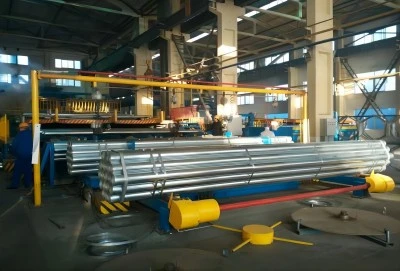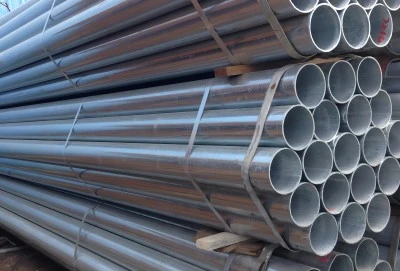ERW galvanized pipe stands out among various galvanized pipe types due to its unique manufacturing process and specific characteristics. Unlike seamless or longitudinally welded pipes, ERW pipes are created using electric resistance welding, offering a balance of strength and cost-effectiveness.
|
|
|
Definitions of Each Galvanized Pipe Type
ERW Galvanized Pipe: Electric Resistance Welded Process
ERW galvanized pipes are manufactured using an electric resistance welding technique. This process involves rolling flat steel strips into a cylindrical shape and welding the seam using high-frequency electrical current. The resulting pipe is then galvanized through hot-dip galvanization, where it's immersed in molten zinc. This coating provides excellent corrosion resistance, making ERW galvanized pipes suitable for various applications in water supply systems, oil and gas transportation, and structural support in buildings and bridges.
Seamless Galvanized Pipe: Continuous Extrusion Method
Seamless galvanized pipes are produced through a continuous extrusion process. A solid steel billet is heated and pierced to create a hollow tube, which is then shaped and sized without any welding. The pipe undergoes hot-dip galvanization to apply the protective zinc coating. Seamless pipes offer uniform strength throughout their structure, making them ideal for high-pressure applications in the oil and gas industry, chemical processing plants, and offshore platforms.
LSAW Galvanized Pipe: Longitudinal Submerged Arc Welding
LSAW galvanized pipes are manufactured using the longitudinal submerged arc welding technique. Steel plates are formed into a cylindrical shape and welded along the length of the pipe. The weld is created under a blanket of granular flux, ensuring a strong and reliable joint. After welding, the pipe is galvanized to enhance its corrosion resistance. LSAW pipes are commonly used in large-diameter applications such as oil and gas transmission pipelines, water mains, and piling for offshore structures.
Key Differences: ERW vs. Other Galvanized Pipes
Manufacturing Process: Welding vs. Extrusion TechniquesThe primary difference between ERW galvanized pipes and other types lies in their manufacturing processes. ERW pipes are created by welding a seam along the length of the pipe, while seamless pipes are extruded from solid billets without any welding. LSAW pipes, on the other hand, involve a more complex welding process using submerged arc welding technology.
These distinct manufacturing methods result in different structural characteristics. ERW pipes have a visible welded seam, which can be a potential weak point under extreme conditions. However, modern welding techniques have significantly improved the strength and reliability of these seams. Seamless pipes offer uniform strength throughout their structure, making them suitable for high-pressure applications. LSAW pipes, with their robust welding process, can handle large diameters and high pressures, making them ideal for major pipeline projects.
Cost-Effectiveness: ERW's Competitive Edge in Production
When it comes to cost-effectiveness, ERW galvanized pipes often have an advantage. The ERW manufacturing process is generally faster and more efficient than the production of seamless or LSAW pipes. This efficiency translates to lower production costs, making ERW pipes an attractive option for projects where budget considerations are paramount.
However, it's important to note that the cost-effectiveness of ERW pipes should be balanced against the specific requirements of each project. While they may be more economical upfront, seamless or LSAW pipes might be necessary for applications requiring higher pressure ratings or larger diameters, potentially offering better long-term value in those scenarios.
Application Range: Industry-Specific Pipe Selection Guide
The choice between ERW galvanized pipes and other types often depends on the specific application and industry requirements. ERW pipes are widely used in water supply systems, fire protection systems, and general plumbing applications. They're also suitable for low to medium-pressure oil and gas lines, as well as structural applications in construction.
Seamless pipes, with their uniform structure, are preferred in high-pressure and high-temperature environments. They're commonly used in oil refineries, petrochemical plants, and power generation facilities. LSAW pipes, capable of large diameters and high pressure ratings, are often the go-to choice for major oil and gas transmission pipelines, especially in offshore applications.
For project managers and engineers in the Middle East, Australia, and Southeast Asia, understanding these application ranges is crucial. The choice of pipe type can significantly impact project success, especially in demanding environments like offshore oil platforms or large-scale water supply systems.
Seam Presence: The Most Fundamental Difference
ERW Pipes: Visible Seam and Its Impact on PerformanceThe presence of a visible seam is the most distinguishing feature of ERW galvanized pipes. This seam, created during the electric resistance welding process, runs along the length of the pipe. While modern welding techniques have significantly improved the strength and reliability of these seams, they can still be considered a potential weak point under extreme conditions.
However, it's important to note that for most standard applications, the seam in ERW pipes does not significantly impact performance. The galvanization process helps to protect the seam, along with the rest of the pipe, from corrosion. In fact, the seam can sometimes be an advantage, allowing for easier installation and alignment in certain applications.
Seamless Pipes: Uniform Structure for High-Pressure Use
Seamless galvanized pipes, as the name suggests, lack any welded seam. This uniform structure gives them an inherent advantage in high-pressure applications. Without a seam, there's no potential weak point along the length of the pipe, allowing for more consistent performance under stress.
This characteristic makes seamless pipes particularly suitable for use in the oil and gas industry, where high pressures are common. They're also preferred in applications involving extreme temperatures or corrosive materials, where the absence of a seam reduces the risk of failure.
Corrosion Resistance: Seam vs. Seamless Comparison
When it comes to corrosion resistance, both ERW and seamless galvanized pipes offer excellent protection due to their zinc coating. However, there can be subtle differences in their long-term performance, particularly in highly corrosive environments.
In ERW pipes, the seam area might be slightly more susceptible to corrosion over time, especially if the galvanization process doesn't fully penetrate the weld area. However, modern galvanization techniques have largely mitigated this issue.
Seamless pipes, with their uniform structure, offer consistent corrosion resistance across the entire pipe surface. This can be advantageous in extremely corrosive environments or in applications where long-term reliability is critical.
For project managers overseeing installations in corrosive environments, such as offshore platforms or chemical processing plants, these considerations can be crucial in pipe selection. The choice between ERW and seamless pipes should balance corrosion resistance needs with other factors like cost and availability.
ERW galvanized pipes, seamless galvanized pipes, and LSAW galvanized pipes each have their unique strengths and ideal applications. ERW pipes offer a cost-effective solution for many standard applications, while seamless pipes excel in high-pressure environments. LSAW pipes bridge the gap, providing strength and reliability for large-diameter applications. The choice between these pipe types should be based on specific project requirements, considering factors such as pressure ratings, corrosion resistance needs, and budget constraints. By understanding these differences, engineers and project managers can make informed decisions to ensure the success and longevity of their piping systems.
ERW Galvanized Pipe For Sale
Hebei Longma Group offers a wide range of ERW galvanized pipes suitable for various industrial applications. Our pipes meet international standards including API 5L, ASTM A53, EN10210, and AS/NZS 1163. With outer diameters ranging from 60.3mm to 1422mm and wall thicknesses from 6.02mm to 50.8mm, we can meet diverse project requirements.
Our state-of-the-art production facilities, imported from Germany, ensure top-notch quality. Our team of over 300 employees, including 60+ technical experts, guarantees professional service and support. We offer comprehensive testing facilities, fast delivery (as quick as 7 days for standard thicknesses), and complete certification including API 5L, ISO 9001, ISO 14001, and more.
Thanks to our long-term partnerships with raw material suppliers and our integrated production model, we offer competitive pricing without compromising on quality. For more information about our pipes, contact us at info@longma-group.com.














